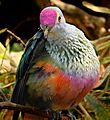Sea Acres National Park facts for kids
Quick facts for kids Sea Acres National ParkNew South Wales |
|
|---|---|
|
IUCN Category II (National Park)
|
|

Boardwalk at Sea Acres
|
|
| Nearest town or city | Port Macquarie |
| Established | 11 March 1987 |
| Area | 0.76 km2 (0.3 sq mi) |
| Managing authorities | NSW National Parks and Wildlife Service |
| Website | Sea Acres National Park |
| See also | Protected areas of New South Wales |
Sea Acres National Park is a special place in New South Wales, Australia. It's located near the town of Port Macquarie on the Mid North Coast. This park covers about 76 hectares (188 acres). It's famous for its beautiful seaside rainforest.
Many people visit Sea Acres National Park. They love walking along the 1.3-kilometer (0.8-mile) long boardwalk. This boardwalk takes you right through the amazing rainforest. The park also has an education center and a cafe. Sea Acres was first protected as a nature reserve in 1987. It officially became a national park in October 2010.
Contents
Discover the Wildlife at Sea Acres National Park
Birds of the Rainforest
Sea Acres National Park is home to over 100 different types of birds. Some rare and beautiful birds live here. You might spot the colorful wompoo fruit-dove. The rose-crowned fruit-dove is another special bird. Look up to see the majestic osprey flying overhead.
Reptiles and Mammals
The park is also home to many reptiles. Keep an eye out for the large lace monitor. You might also see the shiny land mullet lizard. The diamond python is another cool reptile here.
Twenty-one different types of mammals live in Sea Acres National Park. This includes the adorable koala. You might even see a spotted-tail quoll, which is a unique marsupial. The tiny little bent-wing bat also calls this park home. Even two rare types of snails live here!
Explore the Plants of Sea Acres National Park
Coastal Rainforest Trees
Sea Acres National Park has one of the biggest and best coastal rainforests in New South Wales. This type of forest is very special. Most seaside forests like this have been cleared for farms or buildings. But here, you can still see a large part of it.
Many common trees grow in this rainforest. These include the tuckeroo and coogara. You can also find the red olive berry and white walnut. Other trees are the flintwood and the huge strangler fig. Look for the sour cherry and Francis watergum. The maiden's blush and mock olive are also here.
Vines and Palms
Vines are very common in the rainforest. They include the lawyer vine and supplejack. The water vine is another common sight. You will often see tall Walking stick palms and Bangalow palms.
Epiphytes and Ferns
In the taller, more protected parts of the forest, you'll find many Epiphytes. These are plants that grow on other plants. Examples include the amazing staghorn and elkhorn ferns. The hare's foot fern is an interesting climbing plant. The very tall areas in the gullies might feel more like a sub-tropical rainforest.
Rare Coastal Plants
Some plants here are at the edge of their natural range. The widespread sea hibiscus reaches its southernmost limit here. The screw pine also grows here, which is unusual. This plant is usually found on tropical Pacific islands. The rare flat fork fern was once found at Sea Acres, but its exact spot is now unknown.
A rainforest expert named Alexander Floyd thinks that Sea Acres and similar forests near Port Macquarie are special. He believes they are "refugia" from a time when the climate was warmer. This means they are places where plants survived when they died out elsewhere.
Other Forest Types
Besides rainforest, Sea Acres National Park also has other areas. These include open grasslands and banksia woodlands. There are also eucalyptus forests with tall trees like tallowwood, blackbutt, and Sydney blue gum.
Challenges for the Park
Weeds and Pests
Like many natural areas, Sea Acres National Park faces challenges. Some invasive weeds grow here. These include lantana, morning glory, and bitou bush. People dumping garden waste makes this problem worse. Also, feral dogs, foxes, and cats can harm the local wildlife.
Gallery





